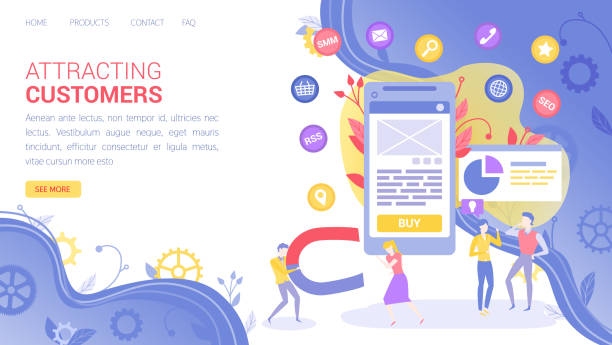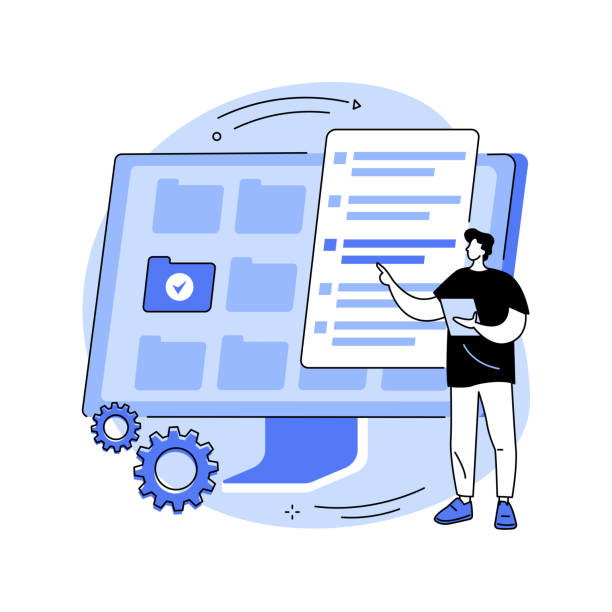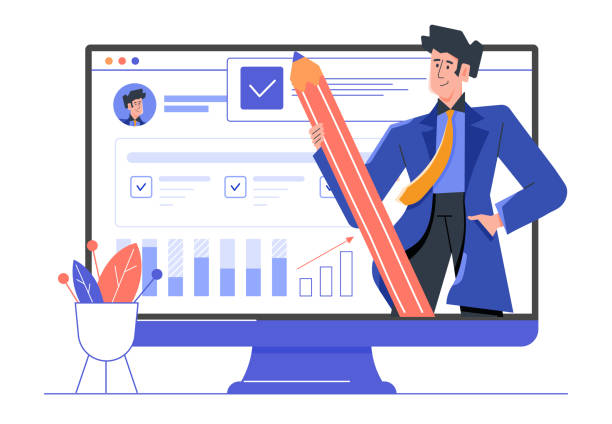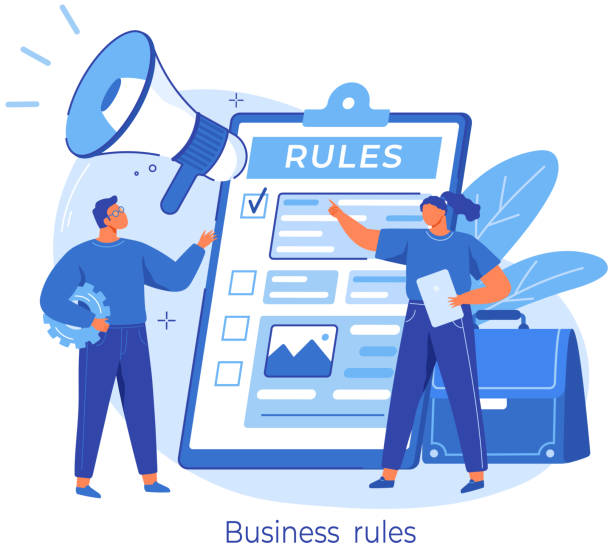Introduction to Fast Website Design
In today’s digital world, website speed is not just an advantage, but an undeniable necessity.
Fast website design means building a website that loads for users in the shortest possible time.
This directly impacts #user_experience, #conversion_rate, and even #search_engine_ranking.
When a user enters a website and is forced to wait for pages to load, they will likely leave the website and go to your competitors.
This phenomenon is known as “Bounce Rate” and has a significant negative impact on your business’s online performance.
The goal of fast website design is to provide a smooth and uninterrupted user experience that leads to increased customer satisfaction and, ultimately, business growth.
In this explanatory article, we will examine various aspects of website speed, factors influencing it, and practical solutions for speed optimization.
The importance of this issue is such that even Google has considered page load speed as one of the key factors in its ranking algorithms.
Therefore, attention to speed is vital at every stage of website design and development.
A slow website can lead to the loss of potential customers, reduced revenue, and damage to brand reputation.
Did you know that customers’ first impression of your company is your website? Multiply your business’s credibility with a powerful corporate website from Rasawweb!
✅ Exclusive and eye-catching design tailored to your brand
✅ Improved user experience and increased customer attraction
⚡ Get a free consultation!
The Importance of Website Speed in User Experience and SEO
Website loading speed is closely linked to user experience (UX) and search engine optimization (SEO).
From a user’s perspective, nothing is more frustrating than waiting for a web page to load.
Research shows that most users expect a web page to load in less than three seconds, and if this time increases, the likelihood of leaving the website sharply rises.
This directly affects your Conversion Rate; the slower your website, the fewer customers will make a purchase, register, or use your services.
From an SEO perspective, Google and other search engines consider speed an important factor in website ranking.
Faster websites achieve better rankings in search results, which means greater visibility and higher organic traffic.
A fast-loading website not only provides a better user experience but also allows search engine crawlers to index more pages in less time.
This comprehensive analysis indicates that investing in fast website design is, in fact, an investment in the long-term success of your online business.
Speed also impacts Pay-Per-Click (PPC) advertising costs; faster websites achieve higher Quality Scores, which can lead to lower cost per click.
Key Factors Affecting Website Loading Speed
Numerous factors affect a website’s loading speed, and understanding these factors is the first step towards fast website design.
One of the most important is server response time, which refers to the speed at which the server processes a user’s request and sends the first byte of information.
Low-quality hosting or overloaded servers can significantly increase this time.
Another factor is the size and optimization of images and multimedia files.
Large images without proper compression can drastically reduce loading speed.
CSS and JavaScript files also play an important role.
Using optimized coding, compression and removal of extra code (minification and concatenation), and asynchronous loading of these files can make a significant difference in speed.
Additionally, using browser caching and server caching can reduce the need to reload files on subsequent visits by temporarily storing them.
Finally, utilizing Content Delivery Networks (CDN) to deliver content from the closest server to the user significantly improves speed.
Below is a table of the most important factors and solutions to address them:
| Causative factor of slowness | Explanation | Solution for fast website design |
|---|---|---|
| High server response time | Low-quality hosting or server being far from the user | Choosing reputable hosting, using nearby servers, optimizing the database |
| Large image files | Uncompressed photos or those with inappropriate dimensions | Image compression, using next-gen formats (WebP), lazy loading |
| Bulky and unoptimized CSS/JS files | Extra code, multiple files, synchronous loading | Minification, Concatenation, Async/Defer loading, removing unused code |
| Lack of caching | Files not being stored in the user’s browser | Configuring browser and server caching |
| Lack of CDN usage | Loading content from a single central server for all users | Using CDN to distribute content worldwide |
Click here to preview your posts with PRO themes ››
Tools and Techniques for Website Speed Optimization
To ensure fast website design, it is essential to use analytical tools and implement optimization techniques.
Tools such as Google PageSpeed Insights, GTmetrix, and Lighthouse help you evaluate your website’s performance and identify its weaknesses.
These tools provide detailed reports on loading time, page size, number of requests, and recommendations for improvement.
Practical techniques for increasing speed include: GZIP compression for text files, image optimization using new formats like WebP and compression tools, and minifying CSS and JavaScript files.
Another increasingly popular technique is Lazy Loading.
This method ensures that images and videos are loaded only when the user scrolls to the relevant section of the page, which is particularly useful for long pages with a lot of visual content.
Additionally, ensuring the use of HTTP/2 or HTTP/3 protocols can also help improve overall communication performance.
Proper implementation of these techniques are important steps towards fast website design and delivering an excellent user experience.
Does your current website convert visitors into customers or drive them away? Solve this problem forever with professional corporate website design by Rasawweb!
✅ Build strong credibility and branding
✅ Attract target customers and increase sales
⚡ Get a free consultation now!
The Role of Hosting and Infrastructure in Fast Website Design
Your chosen hosting infrastructure is the backbone of a fast website design.
Hosting quality directly impacts your server response time and website stability.
Shared hosting, though cheaper, shares server resources with many other websites, which can lead to reduced speed during peak hours.
In contrast, VPS (Virtual Private Server) hosting or dedicated servers provide more resources and are more suitable for websites with high traffic or greater complexity.
Cloud Hosting is also a flexible and scalable option that allows you to adjust resources based on your needs and only pay for what you use.
In addition to the type of hosting, the physical location of the servers is also important.
The closer the server is to your target audience, the lower the latency and consequently the faster the loading speed you will have.
Choosing a hosting provider with a strong infrastructure, stable network, and efficient technical support is an essential step in guaranteeing your website’s speed and stability.
This specialized part of design requires precision and planning to prevent potential future issues.
Caching and Content Delivery Networks (CDN) for More Speed
Caching is one of the most powerful methods for increasing website speed.
This process involves temporarily storing website data (such as images, CSS, JavaScript, and even complete HTML pages) in a location closer to the user or server so that on subsequent visits, there is no need to reload them from the main server.
There are two main types of caching: Browser Caching and Server-Side Caching.
Browser caching allows the user’s browser to store static website files in its local memory, while server-side caching stores pre-generated versions of pages on the server.
Content Delivery Networks (CDN) also play a complementary and vital role in this area.
A CDN is a network of servers in various geographical locations around the world that store copies of your website’s static content.
When a user visits your website, the content is delivered to them from the closest CDN server, not from your main server.
This significantly reduces loading time, especially for users geographically distant from the main server, and is an effective way for fast website design.
CDN also helps reduce the load on your main server by distributing traffic and makes the website more resilient against DDoS attacks.
Optimizing Images and Multimedia Files
Images and multimedia files are often the biggest culprits for slow websites.
Proper optimization of these is one of the most important steps toward fast website design.
The first step is image compression without a noticeable loss of quality.
Online tools and CMS plugins can be used for this purpose.
The use of next-generation image formats like WebP, which have smaller file sizes and offer acceptable quality, is highly recommended.
Click here to preview your posts with PRO themes ››
The second step is ensuring the correct dimensions for images.
Loading an image with dimensions larger than actually needed only adds extra bulk to the page.
Use “srcset” and “sizes” attributes in HTML to provide responsive images, allowing the browser to choose the optimal image size based on the user’s device.
For videos, instead of hosting them directly on your server, use specialized platforms like YouTube or Vimeo and load them with Lazy Loading.
This ensures that the video only loads when the user intends to view it.
This educational and practical approach helps you significantly improve your website’s loading by optimally managing multimedia resources.
The table below shows practical solutions for optimizing images and multimedia:
| Optimization Technique | Explanation | Benefit for Speed |
|---|---|---|
| Lossless/Lossy Compression | Reducing image file size with no or minimal quality loss | Reduced download time, faster loading |
| Using WebP | Next-gen image format with better compression than JPEG/PNG | Smaller file size, maintains suitable quality |
| Lazy Loading Images/Videos | Loading content only when it enters the user’s viewport | Reduced initial page load, improved Core Web Vitals |
| Responsive Images | Providing different image sizes for different devices | Optimized image loading for each device, preventing excess loading |
| Hosting videos on external platforms | Using YouTube, Vimeo instead of a personal server | Reduced server load, utilization of powerful video infrastructures |
Challenges and Solutions for Fast Website Design Across Different Platforms
Fast website design presents its own challenges across different platforms.
For example, websites built with WordPress, which are highly popular, are prone to slowness due to the use of numerous plugins and themes.
The main solution for WordPress is to use powerful caching plugins (such as WP Super Cache or WP Rocket), optimize the database, and choose lightweight and optimized plugins and themes.
Regular maintenance and removing unnecessary plugins are also crucial for maintaining speed.
For e-commerce websites like Magento or PrestaShop, the main challenge is managing a large volume of product images, complex product information, and numerous tracking scripts.
In these cases, using a CDN, large-scale image compression, and optimizing checkout flows are essential to speed up the entire purchasing process.
Did you know that every second of delay in page loading can lead to a 7% decrease in conversion rates for e-commerce websites?
Websites developed with Custom Code have more control over optimization but require experienced developers to write clean and efficient code.
Database optimization, using lightweight and efficient frameworks, and correct implementation of caching techniques at the application level are among the key solutions for these platforms.
On any platform, continuous monitoring of speed and resolving performance issues is a crucial step in maintaining website speed and efficiency.
Are you tired of your e-commerce site having visitors but no sales? Rasawweb solves your main problem with professional e-commerce website design!
✅ Significant increase in sales with targeted design
✅ Flawless user experience for your customers
⚡ Get a free consultation now!
The Future of Fast Website Design and Emerging Technologies
The world of web is rapidly evolving, and the future of fast website design is no exception.
Numerous emerging technologies are taking shape that have high potential for significantly improving website speeds.
One of the most important is HTTP/3, which is considered the next generation of the HTTP protocol.
HTTP/3 is built upon the QUIC protocol and significantly enhances communication performance by reducing latency and improving packet loss management.
Another rapidly growing technology is the use of Brotli compression, which offers better compression than GZIP and helps reduce the size of text files.
Additionally, the emergence of Serverless Functions and Edge Computing could also play a significant role in speed in the future.
These technologies enable code execution at the closest point to the user, minimizing response time.
Artificial intelligence could also be used in the future for automatic optimization of images, code, and even predicting user behavior for intelligent content loading.
These exciting developments show that the path to website speed optimization is constantly advancing and offering innovative solutions.
Click here to preview your posts with PRO themes ››
Summary and Final Tips for Achieving a High-Speed Website
Achieving fast website design is a continuous and multifaceted process that requires attention to detail from the very beginning of design to the stage of ongoing maintenance and optimization.
As discussed, website speed not only affects user satisfaction but is also a critical factor for your SEO and online commercial success.
From choosing suitable hosting and server optimization to image compression, using caching, and leveraging CDN, every small step can make a big difference in your website’s overall performance.
Remember that speed is not just a number in testing tools; it is your user’s actual experience.
A fast website not only attracts more traffic but also encourages users to spend more time on your website and convert into loyal customers.
Regular monitoring of website performance with analytical tools and continuous updating of optimization techniques will help you maintain speed and competitiveness in the digital market.
Let’s think about how we can build websites that are both aesthetically pleasing and exceptionally performing.
This is an exciting journey whose results will be very sweet!
Frequently Asked Questions
| Number | Question | Answer |
|---|---|---|
| 1 | What does fast website design mean? | Optimizing a website for fast page loading, improving user experience, and SEO ranking. |
| 2 | Why is website loading speed important? | Increases user satisfaction, reduces bounce rate, improves SEO, and boosts conversion rates (sales/actions). |
| 3 | What tools are available for testing website speed? | Google PageSpeed Insights, GTmetrix, Pingdom Tools are common tools. |
| 4 | What are the main factors causing a website to be slow? | Unoptimized images, heavy JavaScript and CSS codes, poor hosting, and lack of caching. |
| 5 | What is “Caching” and how does it help website speed? | Temporarily storing website data in the user’s browser or on the server for faster loading on subsequent visits. |
| 6 | How can we optimize images to increase website speed? | Reducing image size (compression) without significant quality loss, using modern formats (WebP), and setting appropriate dimensions. |
| 7 | What role does CDN (Content Delivery Network) play in fast website design? | Distributing website content across various servers worldwide to deliver content from the closest server to the user. |
| 8 | Does choosing suitable hosting (web hosting) affect website speed? | Yes, quality hosting and powerful servers are essential for fast website loading. |
| 9 | What is Minification and why is it used? | Removing extra characters (white spaces, comments) from HTML, CSS, JavaScript codes to reduce file size. |
| 10 | What is the relationship between responsive design and website speed? | Responsive design means correct display on different devices; if not implemented correctly, it can create extra load and reduce speed. Responsive optimization is important for speed. |
And other advertising agency services by Rasawweb in the field of advertising
Smart Sales Automation: An innovative platform for improving customer behavior analysis with precise audience targeting.
Smart Social Media: A new service for enhancing customer behavior analysis through intelligent data analysis.
Smart Customer Journey Map: A professional solution for increasing website traffic with a focus on SEO-driven content strategy.
Smart Link Building: A professional solution for increasing sales with a focus on precise audience targeting.
Smart Conversion Rate Optimization: Designed for businesses seeking to increase sales through intelligent data analysis.
And over a hundred other services in online advertising, advertising consulting, and organizational solutions
Online Advertising | Advertising Strategy | Advertorial
Resources
How to Increase Your Website Speed?
Complete Guide to Website Optimization
The Importance of SEO in Successful Website Design
Principles of Website Design for Online Success
? To boost your business in the digital world, count on the expertise of “Rasawweb Afarin”! We help you have a powerful and impactful online presence by providing comprehensive digital marketing services, including multilingual website design.
📍 Tehran, Mirdamad Street, next to the Central Bank, South Kazeroun Alley, Ramin Alley, No. 6















